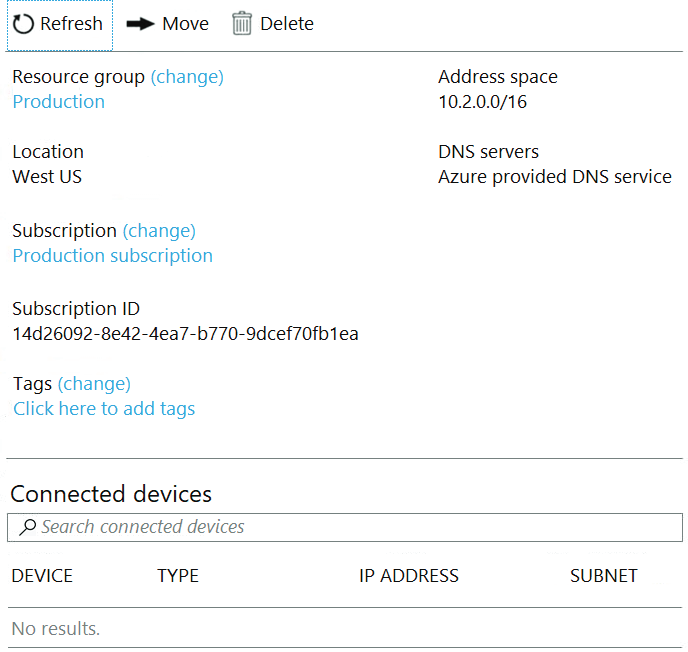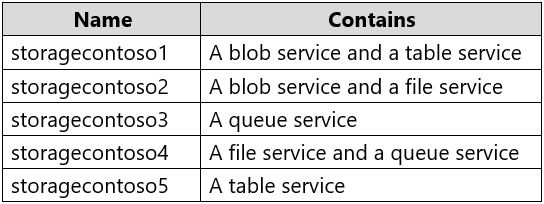Download Microsoft Azure Architect Technologies.AZ-303.Dump4Pass.2021-07-01.178q.vcex
| Vendor: | Microsoft |
| Exam Code: | AZ-303 |
| Exam Name: | Microsoft Azure Architect Technologies |
| Date: | Jul 01, 2021 |
| File Size: | 12 MB |
| Downloads: | 1 |
How to open VCEX files?
Files with VCEX extension can be opened by ProfExam Simulator.
Discount: 20%
Demo Questions
Question 1
You have an Azure subscription that contains 10 virtual machines on a virtual network.
You need to create a graph visualization to display the traffic flow between the virtual machines.
What should you do from Azure Monitor?
- From Activity log, use quick insights.
- From Metrics, create a chart.
- From Logs, create a new query.
- From Workbooks, create a workbook.
Correct answer: C
Explanation:
Navigate to Azure Monitor and select Logs to begin querying the data Reference:https://azure.microsoft.com/en-us/blog/analysis-of-network-connection-data-with-azure-monitor-for-virtual-machines/ Navigate to Azure Monitor and select Logs to begin querying the data
Reference:
https://azure.microsoft.com/en-us/blog/analysis-of-network-connection-data-with-azure-monitor-for-virtual-machines/
Question 2
You have an Azure subscription that contains 100 virtual machines.
You have a set of Pester tests in PowerShell that validate the virtual machine environment.
You need to run the tests whenever there is an operating system update on the virtual machines. The solution must minimize implementation time and recurring costs.
Which three resources should you use to implement the tests? Each correct answer presents part of the solution.
NOTE: Each correct selection is worth one point.
- Azure Automation runbook
- an alert rule
- an Azure Monitor query
- a virtual machine that has network access to the 100 virtual machines
- an alert action group
Correct answer: ABE
Explanation:
AE: You can call Azure Automation runbooks by using action groups or by using classic alerts to automate tasks based on alerts. B: Alerts are one of the key features of Azure Monitor. They allow us to alert on actions within an Azure subscription Reference: https://docs.microsoft.com/en-us/azure/automation/automation-create-alert-triggered-runbookhttps://techsnips.io/snips/how-to-create-and-test-azure-monitor-alerts/?page=13 AE: You can call Azure Automation runbooks by using action groups or by using classic alerts to automate tasks based on alerts.
B: Alerts are one of the key features of Azure Monitor. They allow us to alert on actions within an Azure subscription
Reference:
https://docs.microsoft.com/en-us/azure/automation/automation-create-alert-triggered-runbook
https://techsnips.io/snips/how-to-create-and-test-azure-monitor-alerts/?page=13
Question 3
You have an Azure subscription that contains an Azure Log Analytics workspace.
You have a resource group that contains 100 virtual machines. The virtual machines run Linux.
You need to collect events from the virtual machines to the Log Analytics workspace.
Which type of data source should you configure in the workspace?
- Syslog
- Linux performance counters
- custom fields
Correct answer: A
Explanation:
Syslog is an event logging protocol that is common to Linux. Applications will send messages that may be stored on the local machine or delivered to a Syslog collector. When the Log Analytics agent for Linux is installed, it configures the local Syslog daemon to forward messages to the agent. The agent then sends the message to Azure Monitor where a corresponding record is created. Reference:https://docs.microsoft.com/en-us/azure/azure-monitor/platform/data-sources-custom-logs Syslog is an event logging protocol that is common to Linux. Applications will send messages that may be stored on the local machine or delivered to a Syslog collector. When the Log Analytics agent for Linux is installed, it configures the local Syslog daemon to forward messages to the agent. The agent then sends the message to Azure Monitor where a corresponding record is created.
Reference:
https://docs.microsoft.com/en-us/azure/azure-monitor/platform/data-sources-custom-logs
Question 4
You have a virtual network named VNet1 as shown in the exhibit. (Click the Exhibit tab.)

No devices are connected to VNet1.
You plan to peer VNet1 to another virtual network named VNet2. VNet2 has an address space of 10.2.0.0/16.
You need to create the peering.
What should you do first?
- Configure a service endpoint on VNet2.
- Add a gateway subnet to VNet1.
- Create a subnet on VNEt1 and VNet2.
- Modify the address space of VNet1.
Correct answer: D
Explanation:
The virtual networks you peer must have non-overlapping IP address spaces. The exhibit indicates that VNet1 has an address space of 10.2.0.0/16, which is the same as VNet2, and thus overlaps. We need to change the address space for VNet1. Reference:https://docs.microsoft.com/en-us/azure/virtual-network/virtual-network-manage-peering#requirements-and-constraints The virtual networks you peer must have non-overlapping IP address spaces. The exhibit indicates that VNet1 has an address space of 10.2.0.0/16, which is the same as VNet2, and thus overlaps. We need to change the address space for VNet1.
Reference:
https://docs.microsoft.com/en-us/azure/virtual-network/virtual-network-manage-peering#requirements-and-constraints
Question 5
You have an Azure subscription.
You have 100 Azure virtual machines.
You need to quickly identify underutilized virtual machines that can have their service tier changed to a less expensive offering.
Which blade should you use?
- Metrics
- Customer insights
- Monitor
- Advisor
Correct answer: D
Explanation:
Advisor helps you optimize and reduce your overall Azure spend by identifying idle and underutilized resources. You can get cost recommendations from the Cost tab on the Advisor dashboard. Reference:https://docs.microsoft.com/en-us/azure/advisor/advisor-cost-recommendations Advisor helps you optimize and reduce your overall Azure spend by identifying idle and underutilized resources. You can get cost recommendations from the Cost tab on the Advisor dashboard.
Reference:
https://docs.microsoft.com/en-us/azure/advisor/advisor-cost-recommendations
Question 6
You have an Azure App Service app.
You need to implement tracing for the app. The tracing information must include the following:
- Usage trends
- AJAX call responses
- Page load speed by browser
- Server and browser exceptions
What should you do?
- Configure IIS logging in Azure Log Analytics.
- Configure a connection monitor in Azure Network Watcher.
- Configure custom logs in Azure Log Analytics.
- Enable the Azure Application Insights site extension.
Correct answer: D
Explanation:
For web pages, Application Insights JavaScript SDK automatically collects AJAX calls as dependencies. Note: Some of the things you can track or collect are:What are the most popular webpages in your application, at what time of day and where is that traffic coming from? Dependency rates or response times and failure rates to find out if there’s an external service that’s causing performance issues on your app, maybe a user is using a portal to get through to your application and there are response time issues going through there for instance. Exceptions for both server and browser information, as well as page views and load performance from the end users’ side. Reference: https://azure.microsoft.com/en-us/blog/ajax-collection-in-application-insights/https://blog.pragmaticworks.com/what-is-application-insights For web pages, Application Insights JavaScript SDK automatically collects AJAX calls as dependencies.
Note: Some of the things you can track or collect are:
What are the most popular webpages in your application, at what time of day and where is that traffic coming from?
Dependency rates or response times and failure rates to find out if there’s an external service that’s causing performance issues on your app, maybe a user is using a portal to get through to your application and there are response time issues going through there for instance.
Exceptions for both server and browser information, as well as page views and load performance from the end users’ side.
Reference:
https://azure.microsoft.com/en-us/blog/ajax-collection-in-application-insights/
https://blog.pragmaticworks.com/what-is-application-insights
Question 7
You have an Azure subscription that contains the storage accounts shown in the following table.

You enable Storage Advanced Threat Protection (ATP) for all the storage accounts.
You need to identify which storage accounts will generate Storage ATP alerts.
Which two storage accounts should you identify? Each correct answer presents part of the solution.
NOTE: Each correct selection is worth one point.
- storagecontoso1
- storagecontoso2
- storagecontoso3
- storagecontoso4
- storagecontoso5
Correct answer: AB
Explanation:
Storage Threat Detection is available for the Blob Service. Reference: https://azure.microsoft.com/en-us/blog/advanced-threat-protection-for-azure-storage-now-in-public-preview/ Storage Threat Detection is available for the Blob Service.

Reference:
https://azure.microsoft.com/en-us/blog/advanced-threat-protection-for-azure-storage-now-in-public-preview/
Question 8
You have an Azure virtual machine named VM1 and an Azure Active Directory (Azure AD) tenant named adatum.com.
VM1 has the following settings:
- IP address: 10.10.0.10
- System-assigned managed identity: On
You need to create a script that will run from within VM1 to retrieve the authentication token of VM1.
Which address should you use in the script?
- vm1.adatum.com.onmicrosoft.com
- 169.254.169.254
- 10.10.0.10
- vm1.adatum.com
Correct answer: B
Explanation:
Your code that's running on the VM can request a token from the Azure Instance Metadata Service identity endpoint, accessible only from within the VM: http://169.254.169.254/metadata/identity/oauth2/tokenReference:https://docs.microsoft.com/en-us/azure/active-directory/managed-identities-azure-resources/overview Your code that's running on the VM can request a token from the Azure Instance Metadata Service identity endpoint, accessible only from within the VM: http://169.254.169.254/metadata/identity/oauth2/token
Reference:
https://docs.microsoft.com/en-us/azure/active-directory/managed-identities-azure-resources/overview
Question 9
You are designing an Azure solution.
The solution must meet the following requirements:
- Distribute traffic to different pools of dedicated virtual machines (VMs) based on rules.
- Provide SSL offloading capabilities.
You need to recommend a solution to distribute network traffic.
Which technology should you recommend?
- Azure Application Gateway
- Azure Load Balancer
- Azure Traffic Manager
- server-level firewall rules
Correct answer: A
Explanation:
If you require "SSL offloading", application layer treatment, or wish to delegate certificate management to Azure, you should use Azure's layer 7 load balancer Application Gateway instead of the Load Balanacer. Incorrect Answers:D: Because Load Balancer is agnostic to the TCP payload and TLS offload ("SSL") is not provided.Reference:https://docs.microsoft.com/en-us/azure/application-gateway/overview If you require "SSL offloading", application layer treatment, or wish to delegate certificate management to Azure, you should use Azure's layer 7 load balancer Application Gateway instead of the Load Balanacer.
Incorrect Answers:
D: Because Load Balancer is agnostic to the TCP payload and TLS offload ("SSL") is not provided.
Reference:
https://docs.microsoft.com/en-us/azure/application-gateway/overview
Question 10
Note: This question is part of a series of questions that present the same scenario. Each question in the series contains a unique solution that might meet the stated goals. Some question sets might have more than one correct solution, while others might not have a correct solution.
After you answer a question in this section, you will NOT be able to return to it. As a result, these questions will not appear in the review screen.
You manage an Active Directory domain named contoso.local.
You install Azure AD Connect and connect to an Azure Active Directory (Azure AD) tenant named contoso.com without syncing any accounts.
You need to ensure that only users who have a UPN suffix of contoso.com in the contoso.local domain sync to Azure AD.
Solution: You use Azure AD Connect to customize the synchronization options.
Does this meet the goal?
- Yes
- No
Correct answer: B
Explanation:
Instead use Synchronization Rules Editor to create a synchronization rule. Note: Filtering what objects are synced to Azure AD is a common request and there are many instances where filtering by OU just doesn't cut it. One option is to filter users by their UPN suffix so that only users with the public FQDN as their UPN suffix are synced to Azure AD (e.g., [email protected] would be synced while [email protected] would not). Filtering can be configured using either the GUI (Synchronization Rules Editor) or PowerShell. Reference:https://www.sidekicktech.com/blog/field-notes/2019/upn-suffix-filtering-ad-connect/ Instead use Synchronization Rules Editor to create a synchronization rule.
Note: Filtering what objects are synced to Azure AD is a common request and there are many instances where filtering by OU just doesn't cut it. One option is to filter users by their UPN suffix so that only users with the public FQDN as their UPN suffix are synced to Azure AD (e.g., [email protected] would be synced while [email protected] would not).
Filtering can be configured using either the GUI (Synchronization Rules Editor) or PowerShell.
Reference:
https://www.sidekicktech.com/blog/field-notes/2019/upn-suffix-filtering-ad-connect/
HOW TO OPEN VCE FILES
Use VCE Exam Simulator to open VCE files

HOW TO OPEN VCEX AND EXAM FILES
Use ProfExam Simulator to open VCEX and EXAM files


ProfExam at a 20% markdown
You have the opportunity to purchase ProfExam at a 20% reduced price
Get Now!



